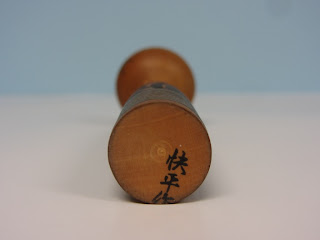 |
| A swan water fountain at a highway rest stop in Iwate Prefecture. |
Early on Sunday, July 1st Naoko, the girls and I hopped in the minivan (an essential vehicle for kokeshi adventures by the way -- perfect for hauling lots of kokeshis back to Tokyo) and once again headed north on the Tohoku Expressway toward the great land of kokeshis. It was day one of an eleven-day trip up to Tohoku and we had pleasant weather the entire drive. As usual we saw all the kokeshi-related signs and exits for famous kokeshi onsens along the highway, but we resisted all urges to get off and continued on to Aomori Prefecture 青森県, our home base for much of the trip. Admittedly, day one really wasn't a kokeshi adventure. However, that night we went to a beautiful onsen and in the gift shop were boxes of kokeshi-themed snacks! I guess our adventure really had begun.
 |
| Little kokeshi-wrapped crackers to bring back home as a present. |
 |
| Kokeshi-themed mini-baum kuchen slices, another good present. |
The next day we went to visit Tsugaru-style kokeshi 津軽系こけし craftsman Ms. Honma Naoko 本間直子さん of Kamikita Town 上北町 in eastern Aomori. As readers may recall, we met her last year and were smitten by her whimsical designs. Like the other masters, Ms. Honma has progressed beyond the standard Tsugaru design and developed her own face style that is easily recognizable. In essence, she has created a face and body design that is incredibly cute.
 |
| In Ms. Honma's workshop, examining wares. |
 |
| Some of Ms. Honma's finely crafted pieces. You'll notice kokeshis of course, but also a daruma-otoshi, hair clips with with her unique kokeshi faces, and other small wooden crafts. |
 |
| Some recently completed Honma kokeshis. |
 |
| Naoko saw this fun character on Ms. Honma's work table and couldn't help but take a picture. |
 |
| Hair clips. Yes, they are adorable. |
 |
| Absolutely beautiful kokeshis with Ms. Honma's trademark maple leaf. She also likes to give her kokeshis big, rosy cheeks. |
 |
| This wasn't for sale, but it's a tiny peach kokeshi designed for a post-tsunami disaster fund-raiser. |
 |
| Most kokeshi makers seem to make Hina kokeshi, a boy and girl brought out at each March on Girl's Day. These are Ms. Honma's version of the tradition, which have bibs. |
 |
| A traditional Tsugaru kokeshi, and as you can see Ms. Honma is a master. Apparently once the traditional design is mastered then a craftsman can start their own variations. |
After discussing kokeshis for a while Ms. Honma brought us to a large nearby park so that the kids could run around and we could enjoy a beautiful, cool Aomori summer day chatting and eating snacks. There are many parks like this up in Aomori I've noticed, as they have the space to build them. It was certainly a refreshing way to spend the early afternoon.
 |
| The lower part of the park. |
 |
| A king-sized lady bug of some sort. |
When it was time to go we bid a fond farewell to Ms. Honma and Kamikita, and then drove through rolling garlic and tobacco fields toward Shichinohe 七戸町, and old castle town that has a brand-new and quite spectacular Shinkansen (Bullet Train) station. Next to the station is a Michi no Eki 道の駅, a chain of roadside shops found throughout Japan that are part farmers' market, part local crafts shop. We went in and what did we find but a very nice selection of Honma kokeshis! Kokeshi adventure part 1 complete!























































